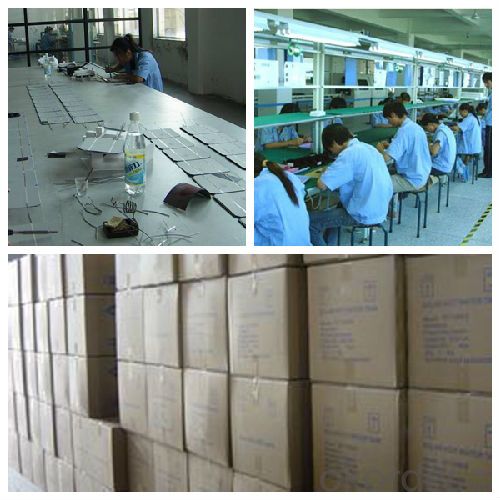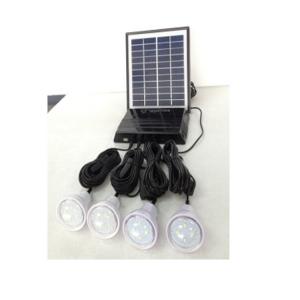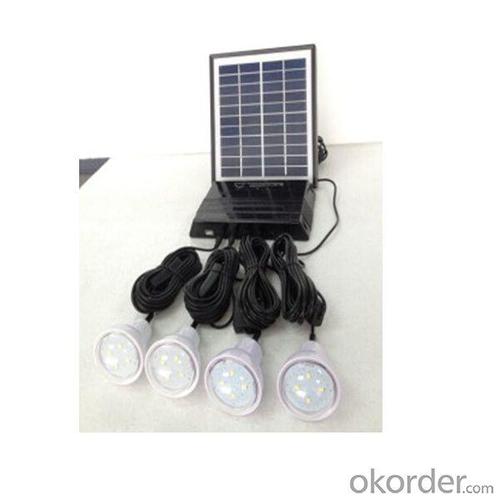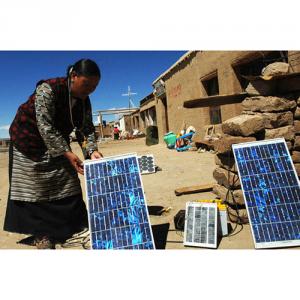Solar Energy Systems Whitehaven 4w 10w 20w 50w 80w 100w Solar Lighting System with Mobile Charge 4 LED Bulbs 4000mAh Li-ion Battery Black CE ROHS
- Loading Port:
- Shenzhen
- Payment Terms:
- TT/LC
- Min Order Qty:
- 100Sets set
- Supply Capability:
- 20000 SETS Per Month set/month
OKorder Service Pledge
OKorder Financial Service
You Might Also Like
This 4w solar lighting system with mobile charge for iphone 4w solar panel 4400mah lithium batetry black ce rohs is a portable solar energy system , solar energy generator can generate power for 4 LED bulbs, it can work 6 hours every day.







Feature
| battery: 7.4V 4400mAh Lithium battery |
| solar panel: 4W 11V Solar Panel with 5M cable |
| led bulbs: 0.9W LED bulb with 4pcs |
| LED bulb: each with 5M cable and switch on cable, IP54. |
| With LED charging indicator: yes |
| Mobile phone charging: USB port 5V 1000mA output, with 5-in-1 USB mobile charging cable (Nokia 6101,Sumsung G600, Micro USB, Mini USB,Iphone 4/4S) |
| Overcharge and overdischarge protection: yes |
| Rechargeable by AC charger: optional |
| Working hours on full battery: |
| 5 bulbs-6 hours |
| 4 bulbs-7.5 hours |
| 3 bulbs-10 hours |
| 2 bulbs-15 hours |
| 1 bulb-30 hours |
| Full charging time |
| By solar-16 hours (under direct sunshine) |
| By AC charger-about 11 hours |
Usage/Applications
Rural homes, campers, fishermen, outdoor campaigns or activities, etc. Remote area, mountainous area, desert area, grassland area,
Village, country area, Camping, outdoor activities, travel, Lighting at night.
Customized options
1. OEM/ODM available;
2. It's also available to customize your own solar lighting systems, solar lanterns, or any solar lighitng products by giving us solar lights picture / 3D draft / technical datas.
Packing & Delivery
Package:
1* solar panel
1* portable system box
4* LED bulbs with on/off button on cable
inner box size: 335*255*84mm
10pcs/carton
carton size:525*350*450mm
Delivery:
|
Shipping Service |
Estimated Delivery Time |
|
DHL |
2-8 business days |
|
FedEx |
3-8 business days |
|
TNT |
2-10 business days |
|
UPS |
1-7 business days |
|
EMS |
6-14 business days |
|
ePacket |
7-12 business days |
|
China Post Air Mail |
7-15 business days |
|
China Post SAL |
14-30 business days |
|
Air freight |
3-10 business days |
|
By Sea |
30-40 business days |
1. 3-5 business days for Sample Orders; 7-30 business days for Bulk Orders for Bulk Orders.
2. "Business days" means Monday-Friday, excluding holidays.
3. DHL and UPS cannot ship to military or P.O. boxes address
4. The Shipping Service above is for reference only, for any other questions, please feel free to contact us.
Factory

- Q: Are there any risks of theft or vandalism with solar energy systems?
- Yes, there are some risks of theft or vandalism associated with solar energy systems. Solar panels, inverters, and batteries can be attractive targets for thieves due to their high value. Additionally, vandalism can occur, such as intentional damage to solar panels or theft of crucial components. However, there are preventive measures that can be implemented, such as installing security systems, using tamper-proof equipment, and ensuring proper insurance coverage to mitigate these risks.
- Q: Can a solar energy system be installed on a community center or clubhouse?
- Yes, a solar energy system can definitely be installed on a community center or clubhouse. In fact, community centers and clubhouses are ideal locations for solar installations due to their large roof spaces and high energy consumption. By installing solar panels on the roof of a community center or clubhouse, the facility can generate clean and renewable electricity to power its operations. Solar energy systems can help reduce electricity bills, lower carbon emissions, and promote sustainable development in the community. Additionally, solar panels can be combined with battery storage systems to store excess energy produced during the day for use during the night or in times of high demand. Overall, installing a solar energy system on a community center or clubhouse is a great way to showcase environmental leadership and inspire others in the community to embrace renewable energy.
- Q: How does the location of a solar energy system affect its performance?
- The location of a solar energy system significantly affects its performance. Solar panels function optimally in areas with abundant sunlight and minimal shading. Regions with high levels of direct sunlight, such as deserts or open plains, are ideal for maximizing solar energy production. Additionally, the tilt and orientation of the panels should be optimized to capture the most sunlight throughout the day. Factors like latitude, climate, and local weather patterns also play a role in determining the efficiency of a solar energy system. Ultimately, choosing the right location can greatly enhance the overall performance and output of a solar energy system.
- Q: How does the efficiency of solar panels vary across different temperatures?
- The efficiency of solar panels typically decreases as the temperature increases.
- Q: Can a solar energy system be used in areas with high winds?
- Indeed, areas with high winds can indeed utilize a solar energy system. Although improper installation could potentially lead to damage caused by the high winds, modern solar panels are engineered to endure various weather conditions, including high winds. Most solar panels are subjected to rigorous testing and certification processes, ensuring their ability to withstand wind speeds of up to 140 miles per hour (225 kilometers per hour). Furthermore, solar panels can be securely mounted either on rooftops or via ground mount systems that are specifically engineered to withstand powerful winds. It is crucial to have the solar energy system installed by professionals who possess knowledge of the local wind patterns and can adeptly design and install the system in order to endure high winds.
- Q: Can solar energy systems be used in powering amusement arcades or gaming centers?
- Yes, solar energy systems can be used to power amusement arcades or gaming centers. Solar panels can be installed on the roof or in nearby open spaces to harness sunlight and convert it into electricity. This renewable energy can then be used to power the electrical equipment, lighting, and other energy-consuming devices within the amusement arcade or gaming center. Implementing solar energy systems not only reduces reliance on traditional energy sources but also saves costs in the long run and promotes sustainable practices.
- Q: What is the role of solar energy systems in reducing air pollution?
- Solar energy systems play a crucial role in reducing air pollution by providing clean and renewable energy. Unlike fossil fuels, solar power does not emit harmful pollutants such as carbon dioxide, nitrogen oxides, or sulfur dioxide during its generation. By utilizing solar energy, we can decrease our reliance on fossil fuels and reduce the emissions that contribute to air pollution and climate change.
- Q: Can a solar energy system be installed on a building with a flat roof?
- Yes, a solar energy system can be installed on a building with a flat roof. Flat roofs provide an ideal surface for mounting solar panels, as they offer a level surface and provide ample space for installation. Furthermore, flat roofs often have unobstructed sun exposure, which is crucial for maximizing the efficiency of solar panels.
- Q: Can solar energy systems be installed in any location?
- Solar energy systems can be installed in most locations, as long as there is sufficient sunlight available. However, the efficiency and effectiveness of the system may vary depending on factors such as the amount of sunlight, shading, and the available roof or ground space for installation.
- Q: Can solar energy systems be used for powering outdoor surveillance cameras?
- Certainly, outdoor surveillance cameras can be powered by solar energy systems. These systems are composed of solar panels that convert sunlight into electrical energy. This electricity can be utilized to operate various devices, including outdoor surveillance cameras. Sunlight captured by the solar panels, when installed near the cameras, is transformed into electrical energy that can be either stored in batteries or used directly to power the cameras. Consequently, there is no need for traditional power sources or the installation of electrical wires in remote locations. This solution is not only cost-effective but also environmentally friendly. Moreover, solar energy systems ensure a dependable and uninterrupted power supply, even in areas with limited access to electricity, thus guaranteeing continuous surveillance capabilities.
1. Manufacturer Overview
| Location | |
| Year Established | |
| Annual Output Value | |
| Main Markets | |
| Company Certifications |
2. Manufacturer Certificates
| a) Certification Name | |
| Range | |
| Reference | |
| Validity Period |
3. Manufacturer Capability
| a) Trade Capacity | |
| Nearest Port | |
| Export Percentage | |
| No.of Employees in Trade Department | |
| Language Spoken: | |
| b) Factory Information | |
| Factory Size: | |
| No. of Production Lines | |
| Contract Manufacturing | |
| Product Price Range | |
Send your message to us
Solar Energy Systems Whitehaven 4w 10w 20w 50w 80w 100w Solar Lighting System with Mobile Charge 4 LED Bulbs 4000mAh Li-ion Battery Black CE ROHS
- Loading Port:
- Shenzhen
- Payment Terms:
- TT/LC
- Min Order Qty:
- 100Sets set
- Supply Capability:
- 20000 SETS Per Month set/month
OKorder Service Pledge
OKorder Financial Service
Similar products
Hot products
Hot Searches
Related keywords





























